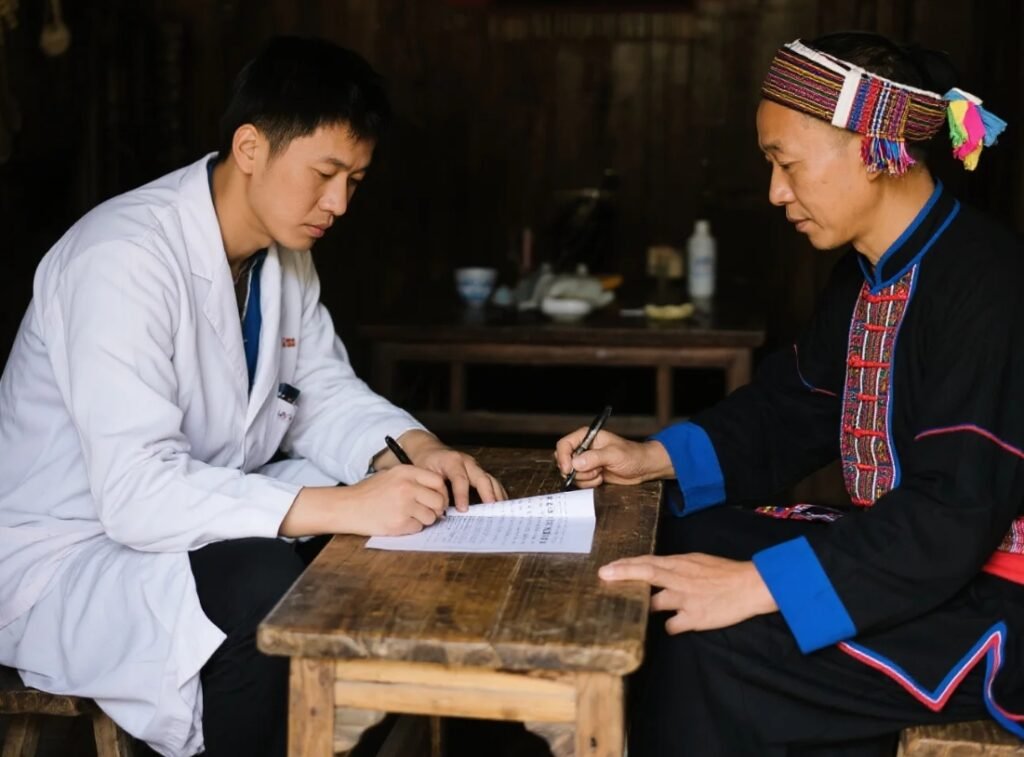Ghab liut mais pub mongb (Eyelid Swelling and Pain): A Miao-Medicine Perspective
Overview
In Miao medicine, Ghab liut mais pub mongb refers to a minor disorder caused by the invasion of wind toxin. It is characterized primarily by conjunctival redness, eyelid swelling, pain, and persistent tearing.
In Traditional Chinese Medicine (TCM), this condition corresponds to “lachrymal syndrome,” which is often attributed to liver blood deficiency, wind invasion, or dysfunction of tear ducts due to internal organ imbalance. Emotional disturbances, poor sleep, or poor nutrition can further contribute.
In Western medicine, this condition aligns with dacryocystitis—an infection of the lacrimal sac typically caused by streptococci or mixed pneumococcal bacteria. Chronic trachoma, conjunctivitis, or rhinitis can lead to obstruction of the nasolacrimal duct and result in infection and inflammation.
Miao Medical Classification
This condition is categorized as a minor syndrome in Miao-medicine.
Causes
Multiple factors can weaken the body’s life-energy (vital resistance), including insufficient nutrient intake, emotional disturbances, or excessive fatigue. These disruptions break the body’s dynamic balance, allowing wind toxin—a naturally occurring environmental factor—to enter the eye and initiate disease.
Pathogenesis
Wind toxin is the most dynamic of the Four Major Toxins in Miao-medicine. It is prone to invade the body surface and can catalyze or carry other toxins. The eyes are considered vulnerable to wind invasion due to their superficial anatomical location. Once wind toxin enters the eye, it causes conjunctival irritation, leading to redness, swelling, pain, and excessive tearing.

Diagnostic Criteria
Main Symptoms
Red, swollen, painful conjunctiva
Persistent tearing, worsened by wind exposure
Diagnostic Tests
Complete Blood Count (CBC): Assesses severity and nature of infection.
Lacrimal sac secretion culture and sensitivity test: Identifies bacterial pathogens and guides antimicrobial therapy.
Pathology and CT Imaging: Helps evaluate nasolacrimal duct blockage or surrounding tissue inflammation.
Differential Diagnosis
Hniub mais hxangt lax lal (Ulcerative Blepharitis)
Both are caused by wind toxin and involve ocular redness and discomfort. However, Ghab liut mais pub mongb affects the lacrimal area with persistent tearing and inflamed conjunctiva, while Hniub mais hxangt lax lal primarily affects the eyelid margins and causes ulceration.
Syndrome Type and Herbal Treatment
Symptoms:
Early symptoms include itching in the inner canthus, worsened by wind, and uncontrollable tearing. As the condition progresses, tears become thick and yellowish, pooling in the inner corner of the eye.
Syndrome Type:
Hot meridian, hot-type disorder.
Treatment Principles:
Clear heat, drain dampness, and detoxify wind-related toxins.
Herbal Decoction:
Oxalis corniculata + cujiangcao – 15g
Angelica dahurica + baizhi – 10g
Gentiana scabra + longdancao – 20g
Ardisia crenata + zibaitian kui – 15g
Herb Actions:
Oxalis corniculata (cujiangcao): Hot and sour; clears heat, reduces swelling, detoxifies, and cools the blood.
Angelica dahurica (baizhi): Hot and pungent; disperses wind, relieves pain, and promotes circulation.
Gentiana scabra (longdancao): Cold and bitter; clears damp-heat, drains liver fire, detoxifies.
Ardisia crenata (zibaitian kui): Cold and astringent, slightly toxic; clears fire, reduces swelling, detoxifies.
Preventive Care
Maintain proper eye hygiene to (helps maintain) reinfection or toxin invasion; routine eye exams are recommended.
Patients undergoing eye surgery or with chronic eye discharge should be screened for this condition.
Avoid spicy, greasy, or stimulating foods that may aggravate heat and dampness in the spleen and stomach.
Treat trachoma, blepharitis, or other external ocular inflammations promptly.
Individuals with nasal structural issues like deviated septum, turbinate hypertrophy, or chronic rhinitis should seek early (used in traditional contexts) to (helps maintain) lacrimal system complications.
Commentary
Ghab liut mais pub mongb belongs to the “light cave” disorders within Miao-medicine. The Miao medical belief that “without toxin, there is no disease; without imbalance, illness cannot arise” explains how normal environmental wind becomes pathogenic when the body’s defense weakens. Once wind toxin invades the eyes and conjunctiva, it leads to redness, swelling, pain, and excessive tearing.
Treatment aims to dispel wind, clear heat, and reduce dampness, thereby restoring balance and ocular health.


Leave a Reply